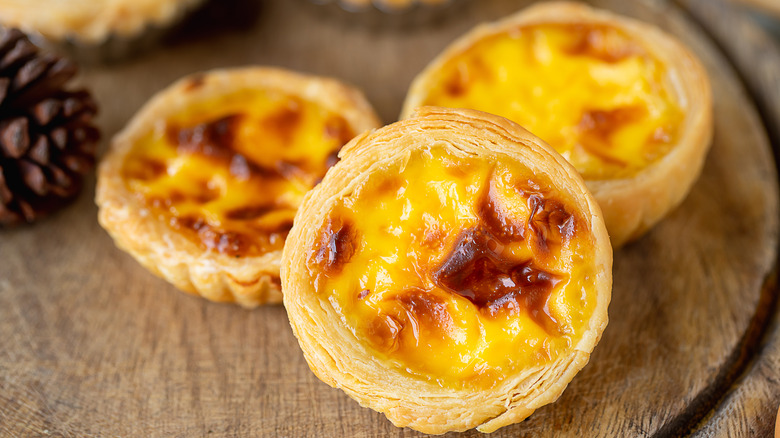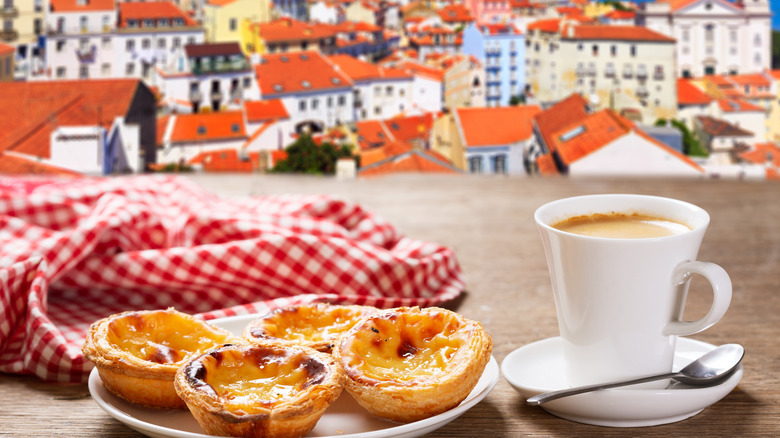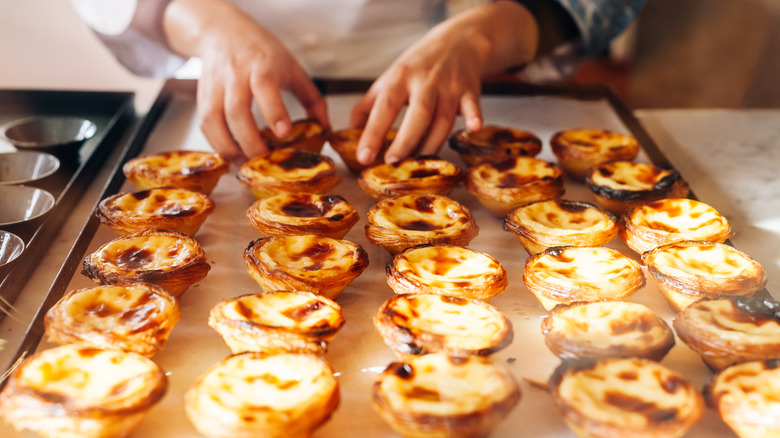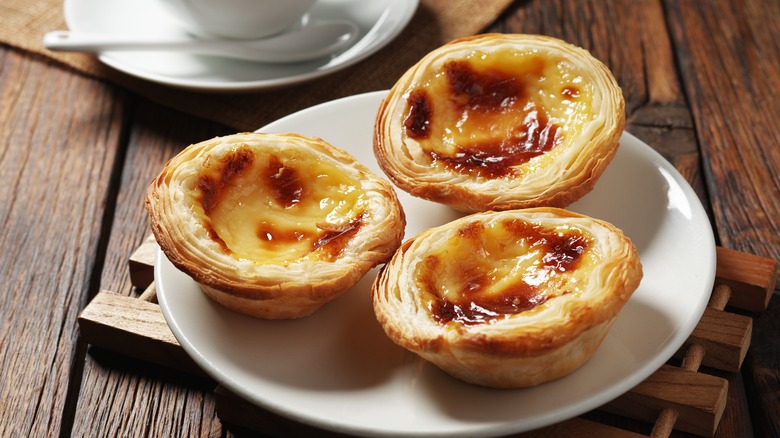What Makes Portugal's Pastel De Nata Egg Tarts Unique
When you think about traveling to Europe to eat, there are a few staple meals that may come to mind. While eating pasta or pizza in Italy, tapas in Spain, or crepes and croque monsieurs in France are ubiquitous options for good reason, a stop for sweet treats in Portugal should be added to the list.
Wandering around the streets of Lisbon, it's not uncommon to see bakeries and pastry shops, and while there are many offerings, the most famous sweet, or perhaps the most enviable, is the pastel de nata — an egg custard-filled pastry. Maybe you've been on a trip to Lisbon, and you've tried Portugal's famous pastel de nata egg tarts, or maybe you just recently watched Eugene Levy fawn over them on the Portugal episode of The Reluctant Traveler. If you have no idea what we're talking about, never fear because you are about to be initiated.
Sweet history
The humble origins of the pastel de nata date back 300 years ago to a monastery in Belem, Portugal, called Jerónimos Monastery. The monastery was located outside of Lisbon and wasn't frequently traveled to, but that has since changed. Back in the day, the clergy and monastery laborers used egg white to starch their garments, which meant that there were lots of egg yolks left over after the week's laundry.
To prevent food waste, the yolks were used to make cakes and sweets, one of which was the pastel de nata. After an 1820 ruling decided to shut down monasteries and convents, by 1834, the monastery did what it needed to do to survive. In an attempt to earn money, the clergy sold these little egg tarts and called them pastéis de bélem and later, they sold the recipe to a sugar refinery nearby. Tarts sold at Pastéis de Bélem are called pastéis de bélem, but other places in Lisbon that sell them refer to them as pastéis de nata. Today the monastery is a UNESCO World Heritage Site where you can visit and try the original recipe for the tarts.
Pastel de nata vs. other egg tarts
If you've never tried a Portuguese egg tart before, think of the texture and flavor profile of crème brûlée custard but baked into a flakey pastry crust. The difference that separates the pastéis de nata custard is that it calls for more egg yolks than a standard custard recipe. Where a crème brûlée custard recipe calls for two egg yolks per 3/4 cup of cream, the pastel de nata recipe calls for six egg yolks per cup of milk. The Portuguese tarts rely more on egg yolks to impart richness, whereas a standard custard relies more heavily on milk or cream. Using that many egg yolks is what gives these little parcels their rich flavor and luscious texture.
Another distinct difference between Portuguese egg tarts and other egg tarts like English egg tarts or Chinese egg tarts is that the Portuguese tart uses only egg yolks and also includes a light puff pastry, whereas the English tart and Chinese egg tart uses whole eggs and a denser pie crust-like dough for the outside. Pasteis de nata have a denser custard but a lighter crust.
How to make them at home
Not planning to travel to Portugal any time soon? No worries, you can easily make this recipe at home. You'll need an egg tart mold, but you can use a muffin tin in a pinch. If you make the puff pastry dough by hand you'll want to let it set overnight before baking your tarts, so this is a recipe to start the day before you plan to enjoy your creation.
Per our Portuguese egg tart recipe, you'll want to prepare your puff pastry and then line your egg tart molds or muffin tins with it. Then put the molds back in the refrigerator to set up while you create your custard. As with any custard recipe, you'll begin by warming your milk and adding your sugar, then will need to temper your egg yolks before mixing them in so you don't end up with scrambled eggs. Once your custard has formed you'll spoon the mixture into the crust before baking at 500 degrees Fahrenheit for 15 to 20 minutes. The idea is for the crust and custard to cook through and for the top of the custard to get caramelized. You'll know they're done when the crust is golden brown, and you see some dark spots of caramelization on the custard. Let the tarts cool for five minutes, and then enjoy them hot and fresh.



